In our second column on biographies this year, we focus on books about creative individuals who have made contributions in the visual, literary, and performing arts. Included are picture book biographies to read aloud and pair with related books and works in other media at all age levels as well as three biographies of authors for independent reading by older readers.
Ages 4–8
Alabama Spitfire: The Story of Harper Lee and To Kill a Mockingbird. Bethany Hegedus. Ill. Erin McGuire. 2018. Balzer + Bray/HarperCollins.
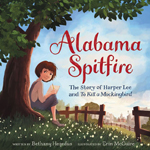 This engaging picture book biography introduces Nelle Harper Lee (1926–2016), who grew up in the segregated, small town of Monroeville, Alabama. Tomboy Nelle played with her brother rather than her sisters and watched her father try cases at the county courthouse. With her friend Tru, she read books, spied on the neighborhood from a treehouse, and wrote stories on an Underwood typewriter. Determined to become an author, Nelle dropped out of law school and moved to New York City. Success came with the publication of her Pulitzer Prize-winning novel, inspired by her own childhood, To Kill a Mockingbird. Back matter includes an extensive author’s note and a bibliography.
This engaging picture book biography introduces Nelle Harper Lee (1926–2016), who grew up in the segregated, small town of Monroeville, Alabama. Tomboy Nelle played with her brother rather than her sisters and watched her father try cases at the county courthouse. With her friend Tru, she read books, spied on the neighborhood from a treehouse, and wrote stories on an Underwood typewriter. Determined to become an author, Nelle dropped out of law school and moved to New York City. Success came with the publication of her Pulitzer Prize-winning novel, inspired by her own childhood, To Kill a Mockingbird. Back matter includes an extensive author’s note and a bibliography.
—CA
Blue Grass Boy: The Story of Bill Monroe, Father of Bluegrass Music. Barb Rosenstock. Ill. Edwin Fotheringham. 2018. Calkins Creek/Highlights.
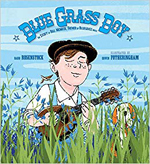 The music of his bluegrass Kentucky home inspired shy Bill Monroe (1911–1996) to become a musician. The youngest of eight children, he joined his brothers’ group, the Monroe Brothers, playing for dances and on local radio stations. After the group broke up, Bill, who was influenced by many musicians, invented bluegrass music, a combination of Scotch–Irish fiddle tunes, gospel, blues, jazz, and country string music. The lively narrative and bright illustrations reflect the joy in the music that Bill Monroe’s Blue Grass Boys played for dances, in the studio, and at the Grand Ole Opry. Back matter includes additional biographical details and a bibliography.
The music of his bluegrass Kentucky home inspired shy Bill Monroe (1911–1996) to become a musician. The youngest of eight children, he joined his brothers’ group, the Monroe Brothers, playing for dances and on local radio stations. After the group broke up, Bill, who was influenced by many musicians, invented bluegrass music, a combination of Scotch–Irish fiddle tunes, gospel, blues, jazz, and country string music. The lively narrative and bright illustrations reflect the joy in the music that Bill Monroe’s Blue Grass Boys played for dances, in the studio, and at the Grand Ole Opry. Back matter includes additional biographical details and a bibliography.
—SW

Libba: The Magnificent Musical Life of Elizabeth Cotten. Laura Veirs. Ill. Tatyana Fazlalizadeh. 2018. Chronicle.
Elizabeth Cotten (1893–1987) heard music in the sounds of the world and recreated them on her brother’s guitar, which, as a left-handed person, she played upside down and backward. After composing her first song, “Freight Train,” at age 13, her life took a different track, and she didn’t return to music until decades later, when Ruth Crawford Seeger hired her as a housekeeper. Libba found herself surrounded by folk music again in the Seeger household. Earth-toned graphite illustrations, tinted digitally, reflect Libba’s gentle, quiet quality. Back matter includes an extensive author’s note and sources.
—SW
Ordinary, Extraordinary Jane Austen. Deborah Hopkinson. Ill. Qin Leng. 2018. Balzer + Bray/HarperCollins.
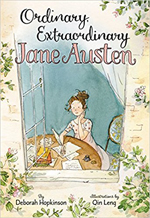 “It is a truth universally acknowledged that Jane Austen is one of our greatest writers.” Deborah Hopkinson begins this biography of Jane Austen (1775–1817) by playing with the opening line of Austen’s Pride and Prejudice (1813). Her simple, straightforward text and Qin Leng’s delicate, softly colored ink-and-watercolor illustrations introduce the life story of the shy, observant British girl who loved to read, began writing stories at an early age, and went on to write extraordinary novels during her short lifetime. Back matter includes a timeline, a “Jane’s Bookshelf” section of Austen’s novels (with publication dates, brief annotations, and famous quotes), and resources.
“It is a truth universally acknowledged that Jane Austen is one of our greatest writers.” Deborah Hopkinson begins this biography of Jane Austen (1775–1817) by playing with the opening line of Austen’s Pride and Prejudice (1813). Her simple, straightforward text and Qin Leng’s delicate, softly colored ink-and-watercolor illustrations introduce the life story of the shy, observant British girl who loved to read, began writing stories at an early age, and went on to write extraordinary novels during her short lifetime. Back matter includes a timeline, a “Jane’s Bookshelf” section of Austen’s novels (with publication dates, brief annotations, and famous quotes), and resources.
—CA
Ages 9–11
Between the Lines: How Ernie Barnes Went from the Football Field to the Art Gallery. Sandra Neil Wallace. Ill. Bryan Collier. 2018. Paula Wiseman/Simon & Schuster.
 Growing up in the segregated south, Ernie Barnes (1938–2009) kept his childhood dream of being an artist alive. “When I became an athlete I didn’t stop being an artist.” Never without a sketchpad, Ernie, reluctantly became a high school football star. Attending college on a sports scholarship, Ernie studied art and played football. Even during his years in professional football, he kept sketching on the sidelines, and after retiring, became the official artist for the American Football League. This picture book biography, with Collier’s stunning watercolor and collage artwork, includes author and illustrator notes, a bibliography, a list of museums exhibiting Barnes’ paintings, and sources.
Growing up in the segregated south, Ernie Barnes (1938–2009) kept his childhood dream of being an artist alive. “When I became an athlete I didn’t stop being an artist.” Never without a sketchpad, Ernie, reluctantly became a high school football star. Attending college on a sports scholarship, Ernie studied art and played football. Even during his years in professional football, he kept sketching on the sidelines, and after retiring, became the official artist for the American Football League. This picture book biography, with Collier’s stunning watercolor and collage artwork, includes author and illustrator notes, a bibliography, a list of museums exhibiting Barnes’ paintings, and sources.
—CA
Born to Swing: Lil Hardin Armstrong’s Life in Jazz. Mara Rockliff. Ill. Michele Wood. 2018. Calkins Creek/Highlights.
 Growing up in Memphis, Tennessee, Lil Hardin (1898–1971) heard the blues outside her window and, although her mother thought it was the devil’s music, she took every chance she had to play the family and church organs with a beat and, in her piano lessons, improvised when she forgot the melody. As part of the Great Migration during World War I, her family moved to Chicago. Surrounded by music and with her independent spirit and vision, she played piano with the great bands of the day, married (and divorced) Louis Armstrong, recorded her music, and went on to perform internationally. Wood’s vibrant paintings depict the times, places, and Lil’s passion for music. Back matter includes additional biographical notes, a timeline, and a bibliography.
Growing up in Memphis, Tennessee, Lil Hardin (1898–1971) heard the blues outside her window and, although her mother thought it was the devil’s music, she took every chance she had to play the family and church organs with a beat and, in her piano lessons, improvised when she forgot the melody. As part of the Great Migration during World War I, her family moved to Chicago. Surrounded by music and with her independent spirit and vision, she played piano with the great bands of the day, married (and divorced) Louis Armstrong, recorded her music, and went on to perform internationally. Wood’s vibrant paintings depict the times, places, and Lil’s passion for music. Back matter includes additional biographical notes, a timeline, and a bibliography.
—SW
Fairy Spell: How Two Girls Convinced the World That Fairies Are Real. Marc Tyler Nobleman. Ill. Eliza Wheeler. 2018. Clarion/Houghton Mifflin.
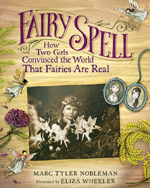 In 1917, cousins Elsie and Frances spent their days in the English countryside, where Elsie took photographs of Frances with her father’s camera and surprised her parents with fairies that appeared in the prints. After the girls’ mothers showed the photographs to a lecturer on fairies, questions circulated. Arthur Conan Doyle became interested and published the first article about the fairies in a popular magazine. Decades later, after renewed interest in the fairies, Elsie and Frances explained their photographs. With delicately detailed artwork and archival photographs, Fairy Spell shows how people came to believe “evidence” of unbelievable events. The author’s note includes remarks on evaluating evidence.
In 1917, cousins Elsie and Frances spent their days in the English countryside, where Elsie took photographs of Frances with her father’s camera and surprised her parents with fairies that appeared in the prints. After the girls’ mothers showed the photographs to a lecturer on fairies, questions circulated. Arthur Conan Doyle became interested and published the first article about the fairies in a popular magazine. Decades later, after renewed interest in the fairies, Elsie and Frances explained their photographs. With delicately detailed artwork and archival photographs, Fairy Spell shows how people came to believe “evidence” of unbelievable events. The author’s note includes remarks on evaluating evidence.
—SW
The Girl Who Drew Butterflies: How Maria Merian’s Art Changed Science. Joyce Sidman. 2018. Houghton Mifflin.
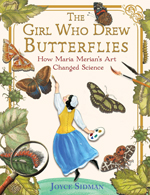 One of the first female entomologists, Maria Merian (1647–1717) cared for her family and home while growing as an artist whose paintings of the life cycles of insects set the standard for scientific illustration for centuries. Her stepfather, who taught her drawing and painting, instilled in her the value of observation of the natural world, something Merian continued all her life as she painted the stages of the life cycle of insects and the plants on which they lived and fed, disproving centuries-old traditional wisdom of how they develop. This beautiful biography includes reproductions of Merian’s paintings and excerpts from her journals. Back matter includes author’s note, quote sources, and selected bibliography.
One of the first female entomologists, Maria Merian (1647–1717) cared for her family and home while growing as an artist whose paintings of the life cycles of insects set the standard for scientific illustration for centuries. Her stepfather, who taught her drawing and painting, instilled in her the value of observation of the natural world, something Merian continued all her life as she painted the stages of the life cycle of insects and the plants on which they lived and fed, disproving centuries-old traditional wisdom of how they develop. This beautiful biography includes reproductions of Merian’s paintings and excerpts from her journals. Back matter includes author’s note, quote sources, and selected bibliography.
—SW
Ages 12–14
Becoming Madeleine: A Biography of the Author of A Wrinkle in Time by Her Granddaughters. Charlotte Jones Voiklis & Léna Roy. 2018. Farrar, Straus and Giroux.
 Educated in European boarding schools, Madeleine L’Engle (1918–2007) was passionate about writing, although she felt “awkward, unattractive, and stupid.” At Smith College, she excelled academically, had her work published, and discovered the theater, in which she was involved for years, noting that the theater was the best training ground for writers. This biography of her writing and family life includes archival photographs and many excerpts from her letters and journals. In the 1950s, one publisher, reviewing a manuscript of a novel, recommended she revise it for young readers. She received many rejections of what became A Wrinkle in Time, the 1962 Newbery Award winner, before it was ultimately published by John Farrar of Farrar, Straus and Giroux. Back matter includes a lengthy authors’ note and acknowledgments.
Educated in European boarding schools, Madeleine L’Engle (1918–2007) was passionate about writing, although she felt “awkward, unattractive, and stupid.” At Smith College, she excelled academically, had her work published, and discovered the theater, in which she was involved for years, noting that the theater was the best training ground for writers. This biography of her writing and family life includes archival photographs and many excerpts from her letters and journals. In the 1950s, one publisher, reviewing a manuscript of a novel, recommended she revise it for young readers. She received many rejections of what became A Wrinkle in Time, the 1962 Newbery Award winner, before it was ultimately published by John Farrar of Farrar, Straus and Giroux. Back matter includes a lengthy authors’ note and acknowledgments.
—SW
House of Dreams: The Life of L. M. Montgomery. Liz Rosenberg. Ill. Julie Morstad. 2018. Candlewick.
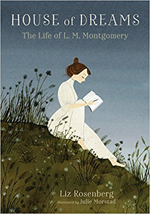 This biography of the creator of the ebullient and optimistic Anne of Green Gables books shows how Maud Montgomery (1874–1942) navigated conflicting influences throughout her life, from the contrast between her energetic and imaginative personality in the household of her pragmatic and serious grandparents to her life fulfilling the responsibilities of a minister’s wife and her career as an author. Maud loved her grandparent’s farm in Cavendish, Prince Edward Island, where she grew up after her mother died and her father retreated to a new life in Saskatchewan. This comprehensive biography chronicles Montgomery’s pursuit of education and teaching, relationships, and devotion to writing.
This biography of the creator of the ebullient and optimistic Anne of Green Gables books shows how Maud Montgomery (1874–1942) navigated conflicting influences throughout her life, from the contrast between her energetic and imaginative personality in the household of her pragmatic and serious grandparents to her life fulfilling the responsibilities of a minister’s wife and her career as an author. Maud loved her grandparent’s farm in Cavendish, Prince Edward Island, where she grew up after her mother died and her father retreated to a new life in Saskatchewan. This comprehensive biography chronicles Montgomery’s pursuit of education and teaching, relationships, and devotion to writing.
—SW
Rosa’s Animals: The Story of Rosa Bonheur and Her Painting Menagerie. Maryann Macdonald. 2018. Abrams.
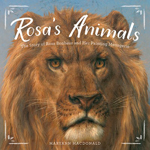 Growing up in France, Rosa Bonheur (1822–1899) studied with her father, Raymond Bonheur, a Realist, in his art studio. At age 19, Rosa’s painting of two rabbits nibbling on a carrot was accepted for the Salon de Paris, a prestigious art show held at the Louvre Museum. During her life, she created hundreds of paintings of wild and domestic animals, including The Horse Fair, recognized as a masterpiece of Realism, which is hung in New York’s Metropolitan Museum of Art. This beautifully crafted biography includes numerous full-page reproductions of Bonheur’s paintings. Back matter includes an author’s note, source notes for quotations, a bibliography, a “Where to See Rosa Bonheur’s Work” section, and an index.
Growing up in France, Rosa Bonheur (1822–1899) studied with her father, Raymond Bonheur, a Realist, in his art studio. At age 19, Rosa’s painting of two rabbits nibbling on a carrot was accepted for the Salon de Paris, a prestigious art show held at the Louvre Museum. During her life, she created hundreds of paintings of wild and domestic animals, including The Horse Fair, recognized as a masterpiece of Realism, which is hung in New York’s Metropolitan Museum of Art. This beautifully crafted biography includes numerous full-page reproductions of Bonheur’s paintings. Back matter includes an author’s note, source notes for quotations, a bibliography, a “Where to See Rosa Bonheur’s Work” section, and an index.
—CA
When Paul Met Artie: The Story of Simon and Garfunkel. G. Neri. Ill. David Litchfield. 2018. Candlewick.
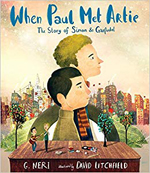 Using a double-page format of free-verse poems paired with colorful, digitally created illustrations, G. Neri and David Litchfield pay tribute to two boys from Queens who became folk rock sensations as teens and are recognized as one of the most successful musical duos of all time. After opening with “Old Friends” about their reunion neighborhood concert in Central Park in 1981, the narrative shifts to 30 years earlier in “My Little Town” to set the scene for the meeting of Paul and Artie. In the final vignette, “Bookends,” they are listening to the top 10 countdown on a car radio on January 1, 1966, when “The Sound of Silence” became the number one song in America. “Paul and Artie / are still just / two boys / from Queens, / dreaming about / the future.” Back matter includes an afterword, discography, bibliography, and list of “musical connections.”
Using a double-page format of free-verse poems paired with colorful, digitally created illustrations, G. Neri and David Litchfield pay tribute to two boys from Queens who became folk rock sensations as teens and are recognized as one of the most successful musical duos of all time. After opening with “Old Friends” about their reunion neighborhood concert in Central Park in 1981, the narrative shifts to 30 years earlier in “My Little Town” to set the scene for the meeting of Paul and Artie. In the final vignette, “Bookends,” they are listening to the top 10 countdown on a car radio on January 1, 1966, when “The Sound of Silence” became the number one song in America. “Paul and Artie / are still just / two boys / from Queens, / dreaming about / the future.” Back matter includes an afterword, discography, bibliography, and list of “musical connections.”
—CA
Ages 15+
Mary’s Monster: Love, Madness, and How Mary Shelley Created Frankenstein. Lita Judge. 2018. Roaring Brook.
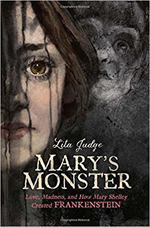 With expressive free-verse poems and double-spread black-and-white illustrations, Lita Judge tells the life story of Mary Wollstonecraft Shelley (1797–1851), the author of Frankenstein (1818). Judge’s intriguing portrait of Mary Shelley and her creation of the classic tale begins with a prologue in which Frankenstein’s monster speaks: “Most people didn’t believe Mary Shelley / a teenage girl, unleashed me, / a creature powerful and murderous / enough to haunt their dreams.” An epilogue, also voiced by the monster, expresses how Mary Shelley’s “. . . spirit whispers / eternally through me, her creature.” This fascinating fictionalized biography includes extensive historical notes, an author’s note, sources of quotations, and a bibliography.
With expressive free-verse poems and double-spread black-and-white illustrations, Lita Judge tells the life story of Mary Wollstonecraft Shelley (1797–1851), the author of Frankenstein (1818). Judge’s intriguing portrait of Mary Shelley and her creation of the classic tale begins with a prologue in which Frankenstein’s monster speaks: “Most people didn’t believe Mary Shelley / a teenage girl, unleashed me, / a creature powerful and murderous / enough to haunt their dreams.” An epilogue, also voiced by the monster, expresses how Mary Shelley’s “. . . spirit whispers / eternally through me, her creature.” This fascinating fictionalized biography includes extensive historical notes, an author’s note, sources of quotations, and a bibliography.
—CA
Sandip LeeAnne Wilson serves as professor in the School of Education and the English Department of Husson University, Bangor, Maine. Carolyn Angus is former director of the George G. Stone Center for Children's Books, Claremont Graduate University, in Claremont, California.
These reviews are submitted by members of the International Literacy Association's Children's Literature and Reading Special Interest Group (CL/R SIG) and are published weekly on Literacy Daily.